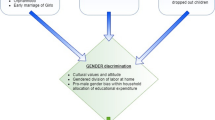Abstract
About 60 years ago India established a policy of providing free and compulsory education to all children and began transforming the elite education system inherited from its colonial past into a mass education program. The task became a race against a rapidly growing population, which outstripped the pace at which children could be enrolled and educated in schools. Notwithstanding this demographic challenge, the system grew in size and the number of children participating in school grew many-fold. The struggle to reach the long cherished goal of universal elementary education continues even today. The present paper highlights two decades of EFA progress, paying particular attention to quantitative trends since 2001, and the policies framed and the strategies implemented to achieve greater equity and quality in the provision of basic education.
Similar content being viewed by others
Notes
For a more detailed discussion of the issue of the Rights-based approach to providing free and compulsory education to all children in India, see Govinda (2007b).
The Annual Status of Education Report (ASER) is carried out every year by Pratham, a national NGO working for primary education in several sates of the country.
For a more comprehensive analysis of this issue, see Govinda and Biswal (2005).
Census of India, 2001, has been conducted in 591 districts out-of the total 593 districts.
MPCE is defined in NSS, 55th round, as the per capital consumer expenditure in the last 30 days of the survey. MPCE = Household’s last 30 days total consumer expenditure/Household size. In the NSS, 55th round, the MPCE classes have been assigned to households based on the data with reference period of “365 days” for items of education, medical expenses (institutional, clothing, footwear, and durable goods and of “last 30 days” for the rest of the items (NSSO 2001, p. 11).
District Information System for Education (DISE) is a comprehensive database on elementary education compiled by and maintained at National University of Educational Planning and Administration (NUEPA).
In addition to the flagship program of Sarva Shiksha Abhiyan, two special programs have been implemented, which focus on social equity and locational disadvantage among girls: the National Program for Education of Girls at Elementary Level (NPEGEL) and the Kasturba Gandhi Balika Vidyalaya. NPEGEL, launched in July 2003 by the Ministry of Human Resource Development, India, constitutes a focused intervention to deliver basic education to the “hardest to reach” girls. The program provides for the establishment of a “model school” with considerable community mobilization and supervision of girls’ school enrollment. Other features of this program include gender sensitization of teachers, development of gender-sensitive learning materials, and provision of need-based incentives like escorts, stationery, workbooks and uniforms. The main goal of the Kasturba Gandhi Balika Vidyalaya (KGBV), launched in July 2004, is to support girls’ education at the upper primary level. The Scheme provides for residential facilities to girls at convenient locations for continuing their education beyond the lower primary stage.
References
Annual status of education report (ASER) (2005). Pratham, New Delhi.
Annual status of education review (ASER) (2006). Pratham, New Delhi.
District Information System for Education (DISE). (2007). Elementary education in India: Progress towards UEE. DISE, Flash statistics (p. 21). New Delhi: NUEPA.
Govinda, R. (2007a). Education for all in India: Assessing progress towards Dakar goals. Background paper for the Education for All Global Monitoring Report, 2008. Paris. UNESCO.
Govinda, R. (2007b). Universal elementary education in India through child rights lens: Some reflections. In Amit Kaushik (Ed.), Shiksha: Challenge of Indian education. New Delhi: Buffalo Publishers.
Govinda, R., & Biswal, K. (2005). Mapping literacy in India: Who and where are the illiterates in India. Global Monitoring Report, Background Papers. Paris: UNESCO.
Govinda, R., & Biswal, K. (2006). Elementary education in India: Promise, performance and prospects. Background paper for the mid-term assessment of 10th five year plan, Human Development Centre, UNDP, New Delhi.
Govinda, R., Biswal, K., Rani, G. (2009). Progress of elementary education across Indian states: Delineating drivers of change and progress, CREATE Project. University of Sussex and NUEPA, New Delhi.
India. Ministry of Human Resource Development. (2005). Mid-term appraisal of 10th five year plan (2002–2007). New Delhi: Planning Commission, Ministry of Human Resource Development, Government of India.
India. Ministry of Human Resource Development. (2006). Aide memoire, 3rd joint review mission of Sarva Shiksha Abhiyan and 22nd joint review mission of district primary education programme. New Delhi: Ministry of Human Resource Development, Government of India.
India. Ministry of Human Resource Development. (2007). Report of the working group on elementary education and literacy for the 11th five year plan. New Delhi: Ministry of Human Resource Development, Government of India.
National Sample Survey Organization (NSSO). (2001). Literacy and levels of education in India, 1999–2000. Report No. 473. New Delhi: Ministry of Statistics and Programme Implementation.
Shaibal, G. (2000). Status of Literacy in India. Asian Development Research Institute, Paper presented at the Summer Literacy Training Programme (SLTP), 2000, International literacy Institute, University of Philadelphia, July 5–28.
Social and Rural Research Institute (SRI) (2005). Survey on assessing the number of out-of-school children in the 6–13 years age group. New Delhi.
Acknowledgments
The author gratefully acknowledges the assistance provided by Mona Sedwal and Madumita Bandopadhyay in collating relevant information for this article, which is a revised and abbreviated version of Govinda (2007a).
Author information
Authors and Affiliations
Corresponding author
About this article
Cite this article
Govinda, R. Education for All in India: assessing progress towards Dakar goals. Prospects 38, 431–444 (2008). https://doi.org/10.1007/s11125-009-9101-6
Published:
Issue Date:
DOI: https://doi.org/10.1007/s11125-009-9101-6




